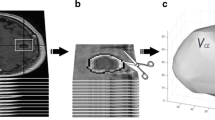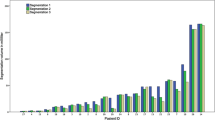Abstract
Purpose
We report a retrospective comparison between bi-dimensional RANO criteria and manual volumetric segmentation (MVS) in pediatric low-grade gliomas.
Methods
MRI FLAIR or T1 post contrast images were used for assessment of tumor response. Seventy patients were included in this single center study, for each patient two scans were assessed (“time 0” and “end of therapy”) and response to therapy was evaluated for both methods. Inter-reader variability and average time for volumetric assessment were also calculated.
Results
Fourteen (20%) of the 70 patients had discordant results in terms of response assessment between the bi-dimensional measurements and MVS. All volumetric response assessments were in keeping with the subjective analysis of tumor (radiology report). Of the 14 patients, 6 had stable disease (SD) on MVS and progressive disease (PD) on 2D assessment, 5 patients had SD on MVS and partial response (PR) on 2D assessment, 2 patients had PD on MVS and SD on 2D assessment, and 1 patient had PR on MVS and SD on 2D analysis. The number of discordant results rises to 21(30%) if minor response is integrated in the response assessment. MVS was relatively fast and showed high inter-reader concordance.
Conclusion
Our analysis shows that therapeutic response classification may change in a significant number of children by performing a volumetric tumor assessment. Furthermore, MVS is not particularly time consuming and has very good inter-reader concordance.


Similar content being viewed by others
References
Colin C, Padovani L, Chappé C et al (2013) Outcome analysis of childhood pilocytic astrocytomas: a retrospective study of 148 cases at a single institution. Neuropathol Appl Neurobiol 39:693–705. https://doi.org/10.1111/nan.12013
Gnekow AK, Falkenstein F, von Hornstein S et al (2012) Long-term follow-up of the multicenter, multidisciplinary treatment study HIT-LGG-1996 for low-grade glioma in children and adolescents of the German Speaking Society of Pediatric Oncology and Hematology. Neuro Oncol 14:1265–1284. https://doi.org/10.1093/neuonc/nos202
Ater JL, Zhou T, Holmes E et al (2012) Randomized study of two chemotherapy regimens for treatment of low-grade glioma in young children: a report from the Children’s Oncology Group. J Clin Oncol 30:2641–2647. https://doi.org/10.1200/JCO.2011.36.6054
Warren KE, Poussaint TY, Vezina G et al (2013) Challenges with defining response to antitumor agents in pediatric neuro-oncology: a report from the response assessment in pediatric neuro-oncology (RAPNO) working group. Pediatr Blood Cancer 60:1397–1401. https://doi.org/10.1002/pbc.24562
Macdonald DR, Cascino TL, Schold SC, Cairncross JG (1990) Response criteria for phase II studies of supratentorial malignant glioma. J Clin Oncol 8:1277–1280
Wen PY, Macdonald DR, Reardon DA et al (2010) Updated response assessment criteria for high-grade gliomas: response assessment in neuro-oncology working group. J Clin Oncol 28:1963–1972. https://doi.org/10.1200/JCO.2009.26.3541
Pope WB, Hessel C (2011) Response assessment in neuro-oncology criteria: implementation challenges in multicenter neuro-oncology trials. AJNR Am J Neuroradiol 32:794–797. https://doi.org/10.3174/ajnr.A2582
Sievert AJ, Fisher MJ (2009) Pediatric low-grade gliomas. J Child Neurol 24:1397–1408. https://doi.org/10.1177/0883073809342005
Laithier V, Grill J, Le Deley M-C et al (2003) Progression-free survival in children with optic pathway tumors: dependence on age and the quality of the response to chemotherapy—results of the first French prospective study for the French Society of Pediatric Oncology. J Clin Oncol 21:4572–4578. https://doi.org/10.1200/JCO.2003.03.043
Packer RJ, Ater J, Allen J et al (1997) Carboplatin and vincristine chemotherapy for children with newly diagnosed progressive low-grade gliomas. J Neurosurg 86:747–754. https://doi.org/10.3171/jns.1997.86.5.0747
Jaspan T, Morgan PS, Warmuth-Metz M et al (2016) Response assessment in pediatric neuro-oncology: implementation and expansion of the RANO Criteria in a randomized phase II trial of pediatric patients with Newly diagnosed high-grade gliomas. AJNR Am J Neuroradiol 37:1581–1587. https://doi.org/10.3174/ajnr.A4782
van den Bent MJ, Wefel JS, Schiff D et al (2011) Response assessment in neuro-oncology (a report of the RANO group): assessment of outcome in trials of diffuse low-grade gliomas. Lancet Oncol 12:583–593. https://doi.org/10.1016/S1470-2045(11)70057-2
Shah GD, Kesari S, Xu R et al (2006) Comparison of linear and volumetric criteria in assessing tumor response in adult high-grade gliomas. Neuro Oncol 8:38–46. https://doi.org/10.1215/S1522851705000529
Kanaly CW, Mehta AI, Ding D et al (2014) A novel, reproducible, and objective method for volumetric magnetic resonance imaging assessment of enhancing glioblastoma. J Neurosurg 121:536–542. https://doi.org/10.3171/2014.4.JNS121952
Warren KE, Patronas N, Aikin AA et al (2001) Comparison of one-, two-, and three-dimensional measurements of childhood brain tumors. J Natl Cancer Inst 93:1401–1405
Kilday J-P, Branson H, Rockel C et al (2015) Tumor volumetric measurements in surgically inaccessible pediatric low-grade glioma. J Pediatr Hematol Oncol 37:e31–e36. https://doi.org/10.1097/MPH.0000000000000168
Lassaletta A, Scheinemann K, Zelcer SM et al (2016) Phase II weekly vinblastine for chemotherapy-Naïve children with progressive low-grade glioma: a Canadian pediatric brain tumor consortium study. J Clin Oncol 34:3537–3543. https://doi.org/10.1200/JCO.2016.68.1585
Henson JW, Ulmer S, Harris GJ (2008) Brain tumor imaging in clinical trials. AJNR Am J Neuroradiol 29:419–424. https://doi.org/10.3174/ajnr.A0963
Wang M-Y, Cheng J-L, Han Y-H et al (2012) Measurement of tumor size in adult glioblastoma: classical cross-sectional criteria on 2D MRI or volumetric criteria on high resolution 3D MRI? Eur J Radiol 81:2370–2374. https://doi.org/10.1016/j.ejrad.2011.05.017
Iliadis G, Selviaridis P, Kalogera-Fountzila A et al (2009) The importance of tumor volume in the prognosis of patients with glioblastoma: comparison of computerized volumetry and geometric models. Strahlenther Onkol 185:743–750. https://doi.org/10.1007/s00066-009-2015-7
Schmidt KF, Ziu M, Schmidt NO et al (2004) Volume reconstruction techniques improve the correlation between histological and in vivo tumor volume measurements in mouse models of human gliomas. J Neurooncol 68:207–215
Galanis E, Buckner JC, Maurer MJ et al (2006) Validation of neuroradiologic response assessment in gliomas: measurement by RECIST, two-dimensional, computer-assisted tumor area, and computer-assisted tumor volume methods. Neuro Oncol 8:156–165. https://doi.org/10.1215/15228517-2005-005
Reuter M, Gerstner ER, Rapalino O et al (2014) Impact of MRI head placement on glioma response assessment. J Neurooncol 118:123–129. https://doi.org/10.1007/s11060-014-1403-8
Gilheeney SW, Kieran MW (2012) Differences in molecular genetics between pediatric and adult malignant astrocytomas: age matters. Future Oncol 8:549–558. https://doi.org/10.2217/fon.12.51
Mistry M, Zhukova N, Merico D et al (2015) BRAF mutation and CDKN2A deletion define a clinically distinct subgroup of childhood secondary high-grade glioma. J Clin Oncol 33:1015–1022. https://doi.org/10.1200/JCO.2014.58.3922
Olsen ØE (2015) Why measure tumours? Pediatr Radiol 45:35–41. https://doi.org/10.1007/s00247-014-3148-0
Ellingson BM, Nguyen HN, Lai A et al (2016) Contrast-enhancing tumor growth dynamics of preoperative, treatment-naive human glioblastoma. Cancer 122:1718–1727. https://doi.org/10.1002/cncr.29957
Akkus Z, Sedlar J, Coufalova L et al (2015) Semi-automated segmentation of pre-operative low grade gliomas in magnetic resonance imaging. Cancer Imaging 15:12. https://doi.org/10.1186/s40644-015-0047-z
Dombi E, Solomon J, Gillespie AJ et al (2007) NF1 plexiform neurofibroma growth rate by volumetric MRI: relationship to age and body weight. Neurology 68:643–647. https://doi.org/10.1212/01.wnl.0000250332.89420.e6
Porz N, Habegger S, Meier R et al (2016) Fully automated enhanced tumor compartmentalization: man vs. machine reloaded. PLoS ONE 11:e0165302. https://doi.org/10.1371/journal.pone.0165302
Bø HK, Solheim O, Jakola AS et al (2017) Intra-rater variability in low-grade glioma segmentation. J Neurooncol 131:393–402. https://doi.org/10.1007/s11060-016-2312-9
Acknowledgments
We thank Mrs. Sara Falcone, Senior MR Radiographer, The Hospital for Sick Children, Toronto, Canada.
Author information
Authors and Affiliations
Corresponding author
Ethics declarations
Funding
No funding was received for this study.
Conflict of interest
ST receives funding support from the National Institute for Health Research, University College London Hospitals Biomedical Research Centre.
Ethical approval
All procedures performed in the studies involving human participants were in accordance with the ethical standards of the institutional and/or national research committee and with the 1964 Helsinki Declaration and its later amendments or comparable ethical standards.
Informed consent
Informed consent was obtained from all individual participants included in the study.
Electronic supplementary material
Supplemental Table 1
(DOCX 14 kb)
Rights and permissions
About this article
Cite this article
D’Arco, F., O’Hare, P., Dashti, F. et al. Volumetric assessment of tumor size changes in pediatric low-grade gliomas: feasibility and comparison with linear measurements. Neuroradiology 60, 427–436 (2018). https://doi.org/10.1007/s00234-018-1979-3
Received:
Accepted:
Published:
Issue Date:
DOI: https://doi.org/10.1007/s00234-018-1979-3




